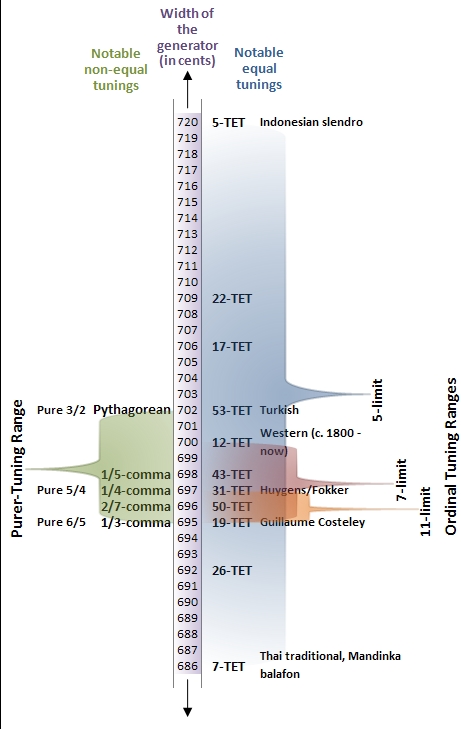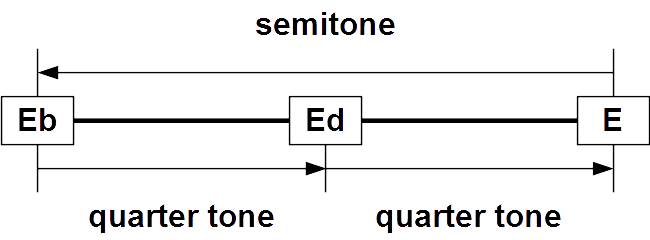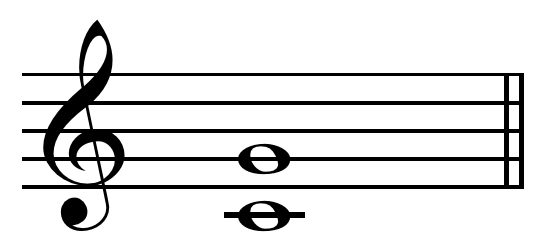|
Major Fourth And Minor Fifth
In music, major fourth and minor fifth are interval (music), intervals from the quarter-tone scale, named by Ivan Wyschnegradsky to describe the tones surrounding the tritone (F/G) found in the more familiar twelve-tone scale,Skinner, Miles Leigh (2007). ''Toward a Quarter-tone Syntax: Analyses of Selected Works by Blackwood, Haba, Ives, and Wyschnegradsky'', p.25. ProQuest. . as shown in the table below: Major fourth A major fourth () is the interval that lies midway between the perfect fourth (500 cent (music), cents) and the augmented fourth (600 cents) and is thus 550 cents (F). It Inversion (interval), inverts to a minor fifth. Wyschnegradsky considered it a good approximation of the eleventh harmonic (11:8 or 551.32 cents). A narrower undecimal major fourth is found at 537 cents (the ratio 15:11). 31 equal temperament has an interval of 542 cents, which lies in between the two types of undecimal major fourth. The term may also be applied to the "comma-deficient major f ... [...More Info...] [...Related Items...] OR: [Wikipedia] [Google] [Baidu] |
Eleventh Harmonic On C
In music or music theory, an eleventh is the note eleven scale degrees from the root of a chord and also the interval between the root and the eleventh. The interval can be also described as a compound fourth, spanning an octave plus a fourth. Since there are only seven degrees in a diatonic scale the eleventh degree is the same as the subdominant In music, the subdominant is the fourth tonal degree () of the diatonic scale. It is so called because it is the same distance ''below'' the tonic as the dominant is ''above'' the tonicin other words, the tonic is the dominant of the subdomina .... The eleventh is considered highly dissonant with the major third. A perfect eleventh is an eleventh which spans exactly 17 semitones. See also * Eleventh chord * Suspended chord References Chord factors Fourths (music) Compound intervals {{music-theory-stub ... [...More Info...] [...Related Items...] OR: [Wikipedia] [Google] [Baidu] |
31 Equal Temperament
In music, 31 equal temperament, 31-ET, which can also be abbreviated 31-TET (31 tone ET) or 31-EDO (equal division of the octave), also known as tricesimoprimal, is the tempered scale derived by dividing the octave into 31 equal-sized steps (equal frequency ratios). Each step represents a frequency ratio of , or 38.71 cents (). 31-ET is a very good approximation of quarter-comma meantone temperament. More generally, it is a regular diatonic tuning in which the tempered perfect fifth is equal to 696.77 cents, as shown in Figure 1. On an isomorphic keyboard, the fingering of music composed in 31-ET is precisely the same as it is in any other syntonic tuning (such as 12-ET), so long as the notes are spelled properly — that is, with no assumption of enharmonicity. History and use Division of the octave into 31 steps arose naturally out of Renaissance music theory; the lesser diesis — the ratio of an octave to three major thirds, 128:125 or 41.06 cents — was approximat ... [...More Info...] [...Related Items...] OR: [Wikipedia] [Google] [Baidu] |
Major Intervals
Major (commandant in certain jurisdictions) is a military rank of commissioned officer status, with corresponding ranks existing in many military forces throughout the world. When used unhyphenated and in conjunction with no other indicators, major is one rank above captain, and one rank below lieutenant colonel. It is considered the most junior of the field officer ranks. Background Majors are typically assigned as specialised executive or operations officers for battalion-sized units of 300 to 1,200 soldiers while in some nations, like Germany, majors are often in command of a company. When used in hyphenated or combined fashion, the term can also imply seniority at other levels of rank, including ''general-major'' or ''major general'', denoting a low-level general officer, and ''sergeant major'', denoting the most senior non-commissioned officer (NCO) of a military unit. The term ''major'' can also be used with a hyphen to denote the leader of a military band such as i ... [...More Info...] [...Related Items...] OR: [Wikipedia] [Google] [Baidu] |
Fifths (music)
Fifth is the ordinal form of the number five. Fifth or The Fifth may refer to: * Fifth Amendment to the United States Constitution, as in the expression "pleading the Fifth" * Fifth column, a political term * Fifth disease, a contagious rash that spreads in school-aged children * Fifth force, a proposed force of nature in addition to the four known fundamental forces * Fifth (Stargate), a robotic character in the television series ''Stargate SG-1'' * Fifth (unit), a unit of volume used for distilled beverages in the U.S. * Fifth-generation programming language * The fifth in a series, or four after the first: see ordinal numbers * 1st Battalion, 5th Marines * The Fraction 1/5 * The royal fifth (Spanish and Portuguese), an old royal tax of 20% Music * A musical interval (music); specifically, a ** perfect fifth ** diminished fifth ** augmented fifth * Quintal harmony, in which chords concatenate fifth intervals (rather than the third intervals of tertian harmony) * Fifth (chord) * ... [...More Info...] [...Related Items...] OR: [Wikipedia] [Google] [Baidu] |
Neutral Interval
In music theory, a neutral interval is an interval that is neither a major nor minor, but instead in between. For example, in equal temperament, a major third is 400 cents, a minor third is 300 cents, and a neutral third is 350 cents. A neutral interval inverts to a neutral interval. For example, the inverse of a neutral third is a neutral sixth. Roughly, neutral intervals are a quarter tone sharp from minor intervals and a quarter tone flat from major intervals. In just intonation, as well as in tunings such as 31-ET, 41-ET, or 72-ET, which more closely approximate just intonation, the intervals are closer together. *Neutral second *Neutral third *Neutral sixth * Neutral seventh Second A neutral second or medium second is an interval wider than a minor second and narrower than a major second. Three distinct intervals may be termed neutral seconds: * The intermediate neutral second, called the lesser undecimal neutral second , has a ratio between the higher-frequenc ... [...More Info...] [...Related Items...] OR: [Wikipedia] [Google] [Baidu] |
Subminor And Supermajor
In music, a subminor interval is an interval that is noticeably wider than a diminished interval but noticeably narrower than a minor interval. It is found in between a minor and diminished interval, thus making it below, or subminor to, the minor interval. A supermajor interval is a musical interval that is noticeably wider than a major interval but noticeably narrower than an augmented interval. It is found in between a major and augmented interval, thus making it above, or supermajor to, the major interval. The inversion of a supermajor interval is a subminor interval, and there are four major and four minor intervals, allowing for eight supermajor and subminor intervals, each with variants. Traditionally, "supermajor and superminor, rethe names given to certain thirds :7 and 17:14found in the justly intoned scale with a natural or subminor seventh."Brabner, John H. F. (1884). The National Encyclopaedia', vol. 13, p. 182. London. Subminor second and supermajor seventh ... [...More Info...] [...Related Items...] OR: [Wikipedia] [Google] [Baidu] |
Apotome (music)
A semitone, also called a half step or a half tone, is the smallest musical interval commonly used in Western tonal music, and it is considered the most dissonant when sounded harmonically. It is defined as the interval between two adjacent notes in a 12-tone scale. For example, C is adjacent to C; the interval between them is a semitone. In a 12-note approximately equally divided scale, any interval can be defined in terms of an appropriate number of semitones (e.g. a whole tone or major second is 2 semitones wide, a major third 4 semitones, and a perfect fifth 7 semitones. In music theory, a distinction is made between a diatonic semitone, or minor second (an interval encompassing two different staff positions, e.g. from C to D) and a chromatic semitone or augmented unison (an interval between two notes at the same staff position, e.g. from C to C). These are enharmonically equivalent when twelve-tone equal temperament is used, but are not the same thing in meantone temp ... [...More Info...] [...Related Items...] OR: [Wikipedia] [Google] [Baidu] |
Richard Bacon (writer)
Richard Mackenzie Bacon (1776–1844) was an English Whig journalist, newspaper proprietor, printer, musician, teacher, and writer. Life He was born in the parish of St Peter Mancroft Norwich 1 May 1776 the only son of Richard Bacon (1745-1812), a printer and proprietor of the Norwich Mercury , one of the leading provincial Whig newspapers. He was educated at the Norwich grammar school and joined his father’s business in 1794. Family Bacon married Jane Louisa Noverre in 1797 (d.1808). She was the daughter of Augustine Noverre, a French dancer who came to England in 1775. Of their children: * Richard Noverre Bacon, the eldest, (died 1884), edited the ''Norwich Mercury''; * Louisa Mary Bacon was known as an educational writer; *Mary Anne Bacon wrote on music; *George Peter Bacon edited the ''Sussex Advertiser''; *Jane Bacon was known as a mezzo-soprano; *Rose Bacon was a musician. Jane Louisa died in 1808, and the September 1809 he married Margaret Gilbert Burks, the daughter ... [...More Info...] [...Related Items...] OR: [Wikipedia] [Google] [Baidu] |
Perfect Fifth
In music theory, a perfect fifth is the musical interval corresponding to a pair of pitches with a frequency ratio of 3:2, or very nearly so. In classical music from Western culture, a fifth is the interval from the first to the last of five consecutive notes in a diatonic scale. The perfect fifth (often abbreviated P5) spans seven semitones, while the diminished fifth spans six and the augmented fifth spans eight semitones. For example, the interval from C to G is a perfect fifth, as the note G lies seven semitones above C. The perfect fifth may be derived from the harmonic series as the interval between the second and third harmonics. In a diatonic scale, the dominant note is a perfect fifth above the tonic note. The perfect fifth is more consonant, or stable, than any other interval except the unison and the octave. It occurs above the root of all major and minor chords (triads) and their extensions. Until the late 19th century, it was often referred to by one of its Gr ... [...More Info...] [...Related Items...] OR: [Wikipedia] [Google] [Baidu] |
Eleventh Harmonic
In music theory, the tritone is defined as a musical interval composed of three adjacent whole tones (six semitones). For instance, the interval from F up to the B above it (in short, F–B) is a tritone as it can be decomposed into the three adjacent whole tones F–G, G–A, and A–B. Narrowly defined, each of these whole tones must be a step in the scale, so by this definition, within a diatonic scale there is only one tritone for each octave. For instance, the above-mentioned interval F–B is the only tritone formed from the notes of the C major scale. More broadly, a tritone is also commonly defined as any interval with a width of three whole tones (spanning six semitones in the chromatic scale), regardless of scale degrees. According to this definition, a diatonic scale contains two tritones for each octave. For instance, the above-mentioned C major scale contains the tritones F–B (from F to the B above it, also called augmented fourth) and B–F (from B to the F above ... [...More Info...] [...Related Items...] OR: [Wikipedia] [Google] [Baidu] |





